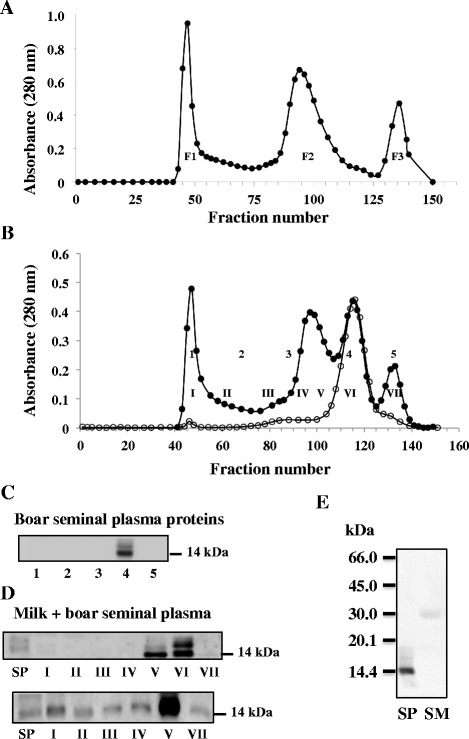Fig. 3.

Gel filtration analysis of milk proteins and interaction between boar BSP1 and milk proteins. a Gel filtration chromatogram of 3 ml of heated skimmed milk alone. b Gel filtration chromatogram of 35 mg of boar SP proteins alone (open circles) or after incubation with skimmed milk (solid circles). Following the elution, tubes were pooled to provide five fractions for boar SP proteins alone (1, tubes 42–51; 2, tubes 52–78; 3, tubes 79–103; 4, tubes 104–128 and 5, tubes 129–139) or seven fractions for SP incubated with milk (I, tubes 42–54; II, tubes 55–71; III, tubes 72–88; IV, tubes 89–94; V, tubes 95–106; VI, tubes 107–124 and VII, tubes 125–138). c Immunoblot analysis of pooled fractions from the elution of boar SP proteins alone. Aliquots equivalent to 0.3 % of each fraction were precipitated and used for immunoblots. d Immunoblot analysis of pooled fractions from the elution of boar SP proteins incubated with skimmed milk. Proteins were precipitated and used for immunoblots (top panel: 0.015 % of fraction VI and 0.03 % of other fractions; bottom panel: 0.3 % of fractions). E) Immunoblot analysis of milk proteins with boar BSP1 polyclonal antibodies. Boar SP proteins (10 μg) and milk proteins (20 μg) were separated by SDS-PAGE, transferred to PVDF and probed with polyclonal antibodies against boar BSP1. The experiments were carried out in triplicates and the results of one typical experiment are shown
